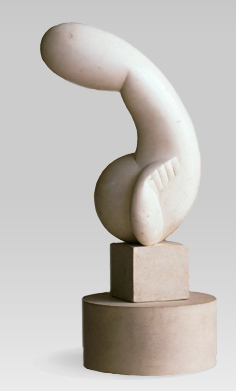|
|
Even Brancusi's most abstract figures seem to have at their core an organic form. A noteworthy example is the artist's treatment of portraiture. His 1912 Muse began as a traditional portrait bust of Renèe Frachon, a friend who also posed for the Sleeping Muse. Another friend, Margit Pogany, was the inspiration for Mlle Pogany II (1919), one of the sculptures that came to epitomize Brancusi's work.
But in the mysterious Princess X (1915) a radical transformation has taken place, in which a human form, taken from an actual individual, becomes totally abstracted. A photograph survives of the first version of this sculpture, in which a woman arches her neck to catch a glimpse of herself in a mirror. The neck is exaggerated in order to convey the self-awareness of this gesture. Dissatisfied with this version, Brancusi carved back the superficial details. The head became an ovoid on an arching neck and the supporting hand is reduced to a pattern. He showed this sculpture in New York, but when the bronze version was exhibited in Paris in 1920 it was banned—to Brancusi's apparent bewilderment—as being deliberately phallic. It was only reinstated as a result of a campaign to support his freedom of expression.
Contantin Brancusi, Princess X, 1915. Marble, 22 x 11 x 9 inches; limestone base, 6 3/8 x 6 3/8 x 5 1/2 inches. Sheldon Memorial Art Gallery and Sculpture Garden, University of Nebraska, Lincoln. Gift of Mrs. Olga N. Sheldon in memory of Adams Bromley Sheldon. © 2004 Artists Rights Society (ARS), New York/ADAGP, Paris.
|
|

